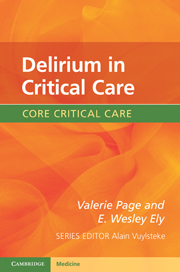Book contents
- Frontmatter
- Contents
- Foreword
- Delirium, a patient testimony
- 1 What is delirium in critical care?
- 2 How common is delirium in critical care?
- 3 What does delirium look like in critical care?
- 4 Delirium in critical care: how does it happen?
- 5 Delirium: what causes it? Risk factors
- 6 Delirium in critical care: why is it important?
- 7 Delirium in critical care: how do we diagnose it?
- 8 How to prevent delirium?
- 9 Treatment of delirium in critical care
- 10 Mental capacity and restraints
- 11 End-of-life care
- 12 What is the future?
- Selected references
- Index
- References
3 - What does delirium look like in critical care?
Published online by Cambridge University Press: 05 December 2011
- Frontmatter
- Contents
- Foreword
- Delirium, a patient testimony
- 1 What is delirium in critical care?
- 2 How common is delirium in critical care?
- 3 What does delirium look like in critical care?
- 4 Delirium in critical care: how does it happen?
- 5 Delirium: what causes it? Risk factors
- 6 Delirium in critical care: why is it important?
- 7 Delirium in critical care: how do we diagnose it?
- 8 How to prevent delirium?
- 9 Treatment of delirium in critical care
- 10 Mental capacity and restraints
- 11 End-of-life care
- 12 What is the future?
- Selected references
- Index
- References
Summary
Introduction
Delirium is not a description of behaviour. Delirium is a medical diagnosis of a syndrome with specific diagnostic features, and significant morbidity and mortality. The diagnosis is primarily clinical and based on careful bedside observation of key features. In 1874 Fothergill writing about delirium summed up ‘…each case differs somewhat from every other case and there are peculiarities in each and every one’. Not very helpful!
Delirium is often missed by clinicians even when they are looking for it. In one intensive care study doctors missed nearly three quarters of cases although the consultants were considerably better at detecting delirium than the residents. In an aptly titled paper Occurrence of delirium is severely underestimated in the ICU, it was shown that nurses picked up only 35% of daily delirium. Though this was poor, this was considerably better than doctors who only detected daily delirium 28% of the time!
So why can delirium be difficult to identify?
Delirium is difficult to spot because it is often quiet – the lethargic patient who is unable to maintain attention is suffering from hypoactive delirium.
Yes! Take note!… the majority of delirium does not present with agitation. On the contrary patients' brains wind down and they become drowsy and reluctant to move rather than the brains winding up and causing hyperactivity. Lipowski called delirium a disorder of wakefulness – too much or too little.
- Type
- Chapter
- Information
- Delirium in Critical Care , pp. 27 - 44Publisher: Cambridge University PressPrint publication year: 2011

